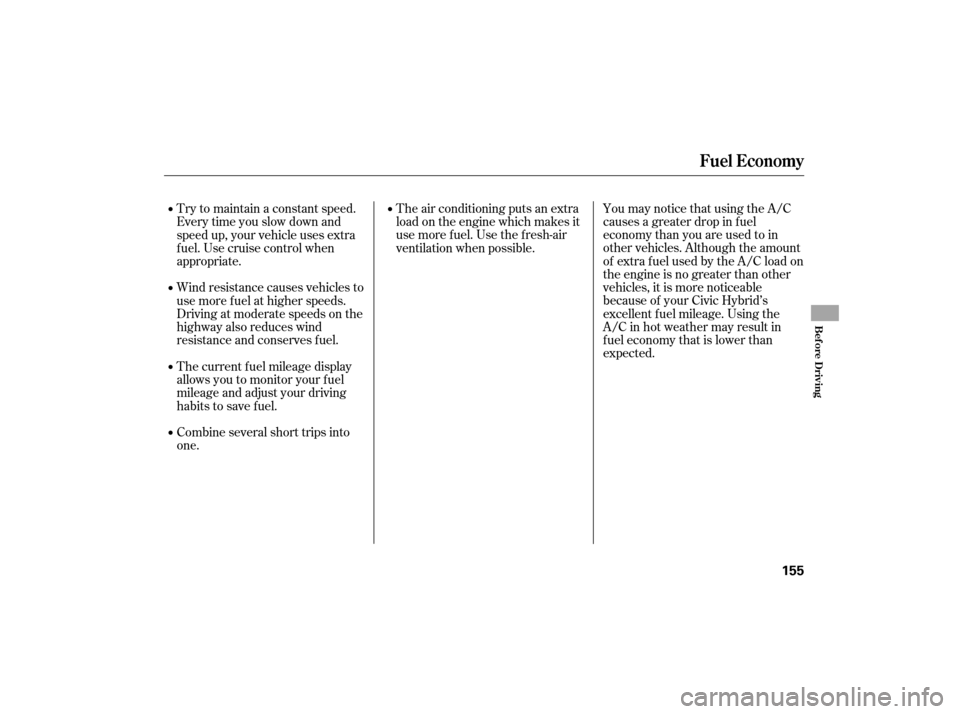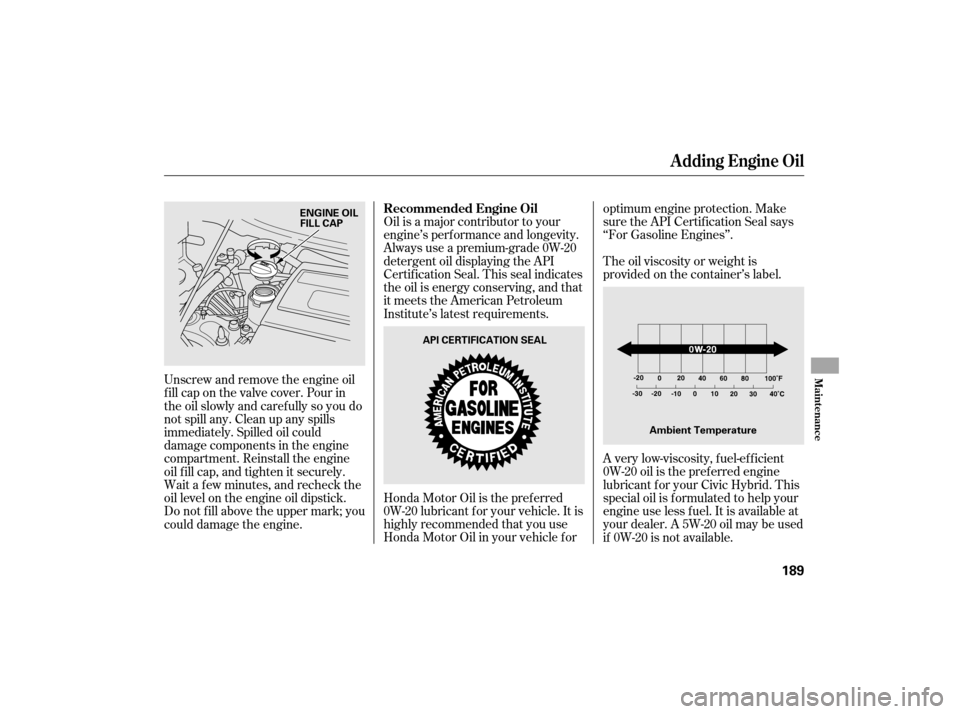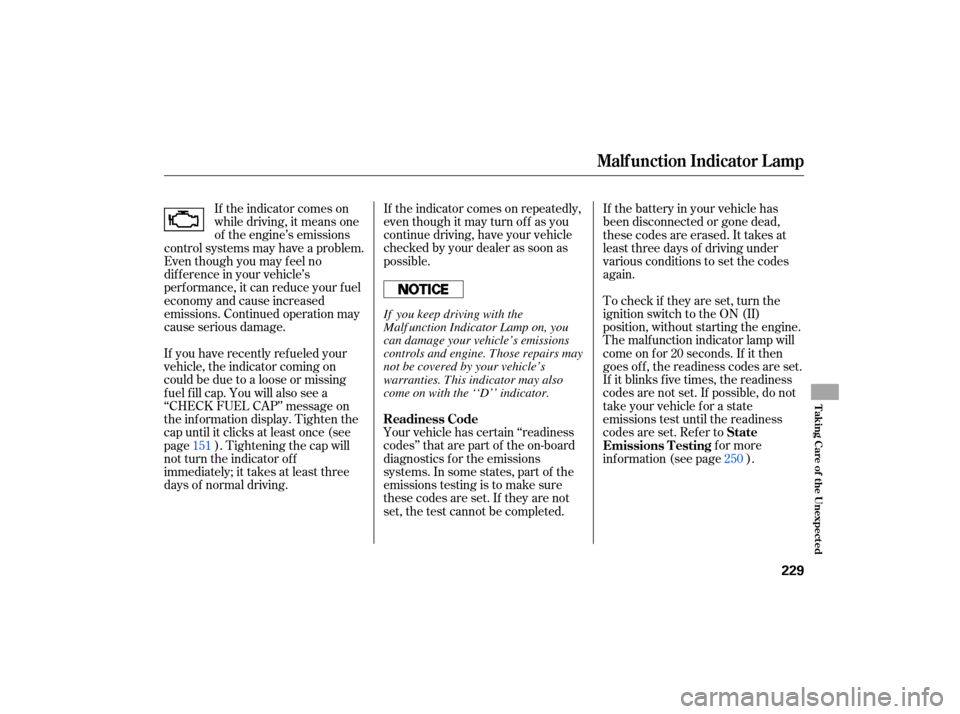Page 158 of 268

You may notice that using the A/C
causes a greater drop in f uel
economy than you are used to in
other vehicles. Although the amount
of extra f uel used by the A/C load on
the engine is no greater than other
vehicles, it is more noticeable
because of your Civic Hybrid’s
excellent f uel mileage. Using the
A/C in hot weather may result in
f uel economy that is lower than
expected.
The air conditioning puts an extra
load on the engine which makes it
usemorefuel.Usethefresh-air
ventilation when possible.
Try to maintain a constant speed.
Everytimeyouslowdownand
speed up, your vehicle uses extra
f uel. Use cruise control when
appropriate.
Wind resistance causes vehicles to
usemorefuelathigherspeeds.
Driving at moderate speeds on the
highway also reduces wind
resistance and conserves f uel.
The current f uel mileage display
allows you to monitor your f uel
mileage and adjust your driving
habits to save fuel.
Combine several short trips into
one.
Fuel Economy
Bef ore Driving
155
Page 187 of 268

�µ�µ�µ
�µ
�µ �µ
�Ì Youshouldcheckthefollowing
items
at the specified intervals. If
you are unsure of how to perform
any check, turn to the appropriate
page listed.
Engine oil level Check every
time you fill the fuel tank. See
page .
Engine coolant level Check the
radiator reserve tank every time
youfillthefueltank.Seepage .
Automatic transmission Check
the fluid level monthly. See page
.
Brakes Check the fluid level
monthly. See page .
Tires Check the tire pressure
monthly. Examine the tread for
wear and foreign objects. See page
. Lights
Check the operation of
the headlights, parking lights,
taillights, high-mount brake light,
tu rn signals, brake lights, and
license plate light monthly. See
page .
According to state and federal
regulations, f ailure to perf orm
maintenance on the items marked
with will not void your emissions
warranties. However, all
maintenance services should be
perf ormed in accordance with the
intervals indicated by the
inf ormation display. 153
154
195 196
207 197
U.S. Vehicles:
Maintenance Minder
Owner’s Maintenance Checks
Maintenance, replacement, or
repair of emissions control
devices and systems may be done
by any automotive repair
establishment or individual using
parts that are ‘‘certif ied’’ to EPA
standards.
184
Page 188 of 268

�Ì�Ì
�Ì
Maintenance Minder
185
: Maintenance
Sub Items
Rotate tires
Replace air cleaner element
If you drive in dusty conditions, replace
every 15,000 miles (24,000 km).
Replace dust and pollen filter
If you drive primarily in urban areas that have high
concentrations of soot in the air from industry and
from diesel-powered vehicles, replace every 15,000
miles (24,000 km).
Inspect drive belt
Replace transmission fluid
Replace spark plugs
Inspect valve clearance
Replace engine coolant
Maintenance
Main Items
Replace engine oil
Replace engine oil and oil filter
Inspect front and rear brakes
Check parking brake adjustment
Inspect these items:
Tie rod ends, steering gear box, and boots
Suspension components
Driveshaft boots
Brake hoses and lines (including ABS)
All fluid levels and condition of fluids
Exhaust system
Fuel lines and connect ions
A
B
Symbol
Symbol
1
2
3
4
5
If the message ‘‘SERVICE OIL’’ does not appear more than 12 months after
the display is reset, change the engine oil every year.
Independent of the maintenance minder display, replace the brake fluid
every 3 years.
Adjust the valves during services A, B, 1, 2, or 3 only if they are noisy.
See information on maintenance and emissions warranty on page .
Inspect idle speed every 160,000 miles (256,000 km).
NOTE: 1:
183
1
1
Maintenance Minder
Page 192 of 268

The oil viscosity or weight is
provided on the container’s label.
Oil is a major contributor to your
engine’s perf ormance and longevity.
Always use a premium-grade 0W-20
detergent oil displaying the API
Certif ication Seal. This seal indicates
the oil is energy conserving, and that
it meets the American Petroleum
Institute’s latest requirements.
Honda Motor Oil is the pref erred
0W-20 lubricant f or your vehicle. It is
highly recommended that you use
Honda Motor Oil in your vehicle f or optimum engine protection. Make
sure the API Certif ication Seal says
‘‘For Gasoline Engines’’.
A very low-viscosity, f uel-ef f icient
0W-20 oil is the pref erred engine
lubricant f or your Civic Hybrid. This
special oil is f ormulated to help your
engine use less fuel. It is available at
your dealer. A 5W-20 oil may be used
if 0W-20 is not available.
Unscrew and remove the engine oil
fill cap on the valve cover. Pour in
the oil slowly and caref ully so you do
not spill any. Clean up any spills
immediately. Spilled oil could
damage components in the engine
compartment. Reinstall the engine
oil f ill cap, and tighten it securely.
Wait a f ew minutes, and recheck the
oil level on the engine oil dipstick.
Do not f ill above the upper mark; you
could damage the engine. Recommended Engine Oil
A dding Engine Oil
Maint enance
189
API CERTIFICATION SEAL
ENGINE OIL
FILL CAP
Ambient Temperature
Page 225 of 268
Are you using a properly coded
key? An improperly coded key will
cause the immobilizer system
indicator in the instrument panel
to blink rapidly (see page ).
Are you using the proper starting
procedure? Refer to
on page .
In
this case, the starter motor’s
speed sounds normal, or even faster
than normal, when you turn the
ignition switch to the START (III)
position, but the engine does not run. Ifyoufindnothingwrong,youwill
need
a qualified technician to find
the problem. See
on page .
Do
you have fuel? Check the fuel
gauge; the low fuel indicator may
not be working.
There may be an electrical
problem, such as no power to the
fuel pump. Check all the fuses
(see page ).
165 59 231 237
T he Starter Operates Normally
Starting the
Engine Emergency
Towing
If theEngineWon’tStart
222
Page 232 of 268

If the indicator comes on repeatedly,
even though it may turn off as you
continue driving, have your vehicle
checked by your dealer as soon as
possible.
If
the indicator comes on
while driving, it means one
of the engine’s emissions
control systems may have a problem.
Even though you may feel no
difference in your vehicle’s
performance, it can reduce your fuel
economy and cause increased
emissions. Continued operation may
cause serious damage. If
the battery in your vehicle has
been disconnected or gone dead,
these codes are erased. It takes at
least three days of driving under
various conditions to set the codes
again.
To check if they are set, turn the
ignition switch to the ON (II)
position, without starting the engine.
The malfunction indicator lamp will
come on for 20 seconds. If it then
goes off, the readiness codes are set.
If it blinks five times, the readiness
codes are not set. If possible, do not
take your vehicle for a state
emissions test until the readiness
codes are set. Refer to
for more
info rmation (see page ).
Your
vehicle has certain ‘‘readiness
codes’’ that are part of the on-board
diagnostics for the emissions
systems. In some states, part of the
emissions testing is to make sure
these codes are set. If they are not
set, the test cannot be completed.
If
you have recently refueled your
vehicle, the indicator coming on
could be due to a loose or missing
fuel fill cap. You will also see a
‘‘CHECK FUEL CAP’’ message on
the information display. Tighten the
cap until it clicks at least once (see
page ). Tightening the cap will
not turn the indicator of f
immediately; it takes at least three
days of normal driving. 151
250State
Emissions T esting
Readiness Code
Malf unction Indicator L amp
T aking Care of t he Unexpect ed
229
If you keep driving with the
Malf unction Indicator Lamp on, you
can damage your vehicle’s emissions
controls and engine. Those repairs may
not be covered by your vehicle’s
warranties. This indicator may also
come on with the ‘‘D’’ indicator.
Page 239 of 268
�µ
�µ
�µ
�µ�µ
�µ
�µ
�µ
�µ
No.
No.No.
Amps.
Amps. Amps.
Circuits Protected Circuits ProtectedCircuits Protected
1
2
3
4
5
6
7
8
9
10
11
12
13
14
15
16 17
18
19
20
21
22
23
24
25
26
27
28
29
30
31
32
33
34
35
36
37
38
7.5 A
7.5 A
10 A
10 A
10 A
7.5 A
7.5 A 10 A
7.5 A
15 A
10 A
7.5 A 10 A
20 A
15 A
20 A
(7.5 A)
(7.5 A)
20 A
20 A
(15 A) 15 A
20 A
20 A
20 A
7.5 A 10 A
7.5 A 30 A
Power Window
Fuel Pump
IG1 ACG
ABS Unit
Not Used
Not Used
Not Used
Not Used ODS
MET ER
SRS
Right Headlight High Beam
Left Headlight High Beam
Small (Interior)
Small (Exterior)
Right Headlight Low BeamLeft Headlight Low Beam
Headlight High Main
Small (Main)
Not Used
Headlight Low Main
(HAC)
STS
Not Used
Door Lock
Driver’s Power Window
Not Used
Rear ACC Socket
ACC
Passenger’s Power Window
Not Used
Right Rear Power Window
Left Rear Power Window
Not Used
ACC Radio
HAC
Daytime Running Light
Wiper
Fuse Locations
236
INTERIOR FUSE BOX
Page 245 of 268

�Î
�Î
�Î
�Î
Specif ications
242
Dimensions
Weights
EngineCapacities
176.7 in (4,489 mm)
69.0 in (1,752 mm)
56.3 in (1,430 mm)
106.3 in (2,700 mm)
59.1 in (1,501 mm)
60.2 in (1,529 mm)
2.87 x 3.15 in (73.0 x 80.0 mm) 82 cu-in (1.339 cm
)
10.8
Length
Width
Height
Wheelbase
Track
Gross vehicle weight rating See the certification label attached
to the driver’s doorjamb.
Type
BorexStroke
Displacement
Compression ratio
Spark plugs ILFR6J-11K SK20HPR-L11 Fuel tank
Engine
coolant
Engine oil
Automatic
transmission
fluid
3.0 US qt (2.8
)
5.4 US qt (5.1)
2.6 US qt (2.5
)
4.8 US qt (4.5)
Including the coolant in the reserve tank and that remaining in the
engine
Reserve tank capacity: 0.108 US gal (0.41
)
Excluding the oil remaining in the engine 13.2 US gal (50
)
1.255 US gal (4.75)
1.59 US gal (6.0)
3.4 US qt (3.2
)
3.2 US qt (3.0)
4.0 US qt (3.8)
Water cooled 4-stroke SOHC i-VTEC
gasoline engine with Hybrid Electric
Front
Rear
Approx.
1:
2: Change
Total
Change
Without filter
Total
Change
Total
U.S. Vehicles
Canada Vehicles
(NGK) (DENSO)
Windshield
washer reservoir
1
2
Including filter